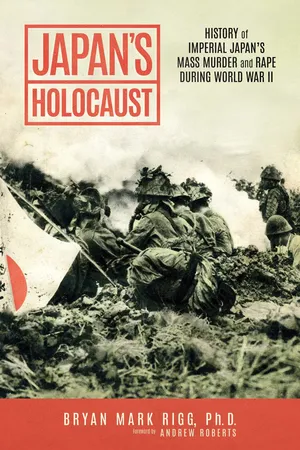
Japan's Holocaust
History of Imperial Japan's Mass Murder and Rape During World War II
- 304 pages
- English
- ePUB (mobile friendly)
- Available on iOS & Android
Japan's Holocaust
History of Imperial Japan's Mass Murder and Rape During World War II
About this book
Japan's Holocaust is a comprehensive exploration of Japan's mass murder and sexual crimes during the Pacific and Asian Wars from 1927 to 1945. Japan's Holocaust combines research conducted in over eighteen research facilities in five nations to explore Imperial Japan's atrocities from 1927 to 1945 during its military expansions and reckless campaigns throughout Asia and the Pacific. This book brings together the most recent scholarship and new primary research to ascertain that Japan claimed a minimum of thirty million lives, slaughtering far more than Hitler's Nazi Germany. Japan's Holocaust shows that Emperor Hirohito not only knew about the atrocities his legions committed, but actually ordered them. He did nothing to stop them when they exceeded even the most depraved person's imagination, as illustrated during the Rape of Nanking as well as many other events. Japan's Holocaust will document in painful detail that the Rape of Nanking was not an isolated event during the Asian War but rather representative of how Japan behaved for all its campaigns throughout Asia and the Pacific from 1927 to 1945.Mass murder, rape, and economic exploitation was Japan's modus operandi during this time period, and whereas Hitler's SS Death's Head outfits attempted to hide their atrocities, Hirohito's legions committed their atrocities out in the open with fanfare and enthusiasm. Moreover, whereas Germany has done much since World War II to atone for its crimes and to document them, Japan has been absolutely disgraceful with its reparations for its crimes and in its efforts to educate its population about its wartime past. Shockingly, Japan continues, in general, to glorify is criminals and its wartime past.
Frequently asked questions
- Essential is ideal for learners and professionals who enjoy exploring a wide range of subjects. Access the Essential Library with 800,000+ trusted titles and best-sellers across business, personal growth, and the humanities. Includes unlimited reading time and Standard Read Aloud voice.
- Complete: Perfect for advanced learners and researchers needing full, unrestricted access. Unlock 1.4M+ books across hundreds of subjects, including academic and specialized titles. The Complete Plan also includes advanced features like Premium Read Aloud and Research Assistant.
Please note we cannot support devices running on iOS 13 and Android 7 or earlier. Learn more about using the app.
Information
Table of contents
- Copyright
- Table of Contents
- Foreword
- Introduction
- Preamble
- Chapter 1: Japan’s Emperor Cult, Intolerant Religions, Hirohito, Fascistic Ideology, and Racist Beliefs
- Chapter 2: Japan’s Racial Tensions with Nazi Germany and Blending Fascist Ideologies
- Chapter 3: Japan’s Martial Culture
- Chapter 4: Japanese Xenophobic and Imperialistic Goals in Practice
- Chapter 5: The Rape of Nanking
- Chapter 6: The Rape of Singapore and Malaya
- Chapter 7: The Bataan Death March
- Chapter 8: The Rape of Guam
- Chapter 9: The Rape of the Philippines and Manila
- Chapter 10: Siam-Burma Railway or “Railroad of Death”
- Chapter 11: Lieutenant General Tadamichi Kuribayashi
- Chapter 12: The Rape of Asia and Hong Kong under Kuribayashi
- Chapter 13: “Comfort Women”: Japanese Sex-Slave Culture
- Chapter 14: Unit 731/Japan’s Human Medical Experimentation Center and Death Camp
- Chapter 15: Japan as a Drug-Dealing Nation
- Chapter 16: Other Japanese Atrocities and Counting the Victims
- Chapter 17: Problems Japan Has Documenting and Atoning for Its Past
- Chapter 18: Mass Murder and Compulsory Suicide of Japanese Civilians by the Japanese
- Chapter 19: Banzais, Seppuku, Jiketsu, and Kamikazes
- Chapter 20: Knowledge of Japan’s Crimes Outside and Inside the Country and Allied Reaction to Japan’s Atrocities
- Chapter 21: Japan’s Honoring of their Criminals and Death Units
- Chapter 22: The Atomic Bombs and Stopping Japan’s Mass Murder
- Chapter 23: Amphibious Warfare: The Marine Corps’ Forte and How It Stopped Hitler’s Genocide and Japan’s Holocaust
- Conclusion
- Interviews by Bryan Mark Rigg
- Bibliography
- Endnotes
- Index
- Acknowledgments